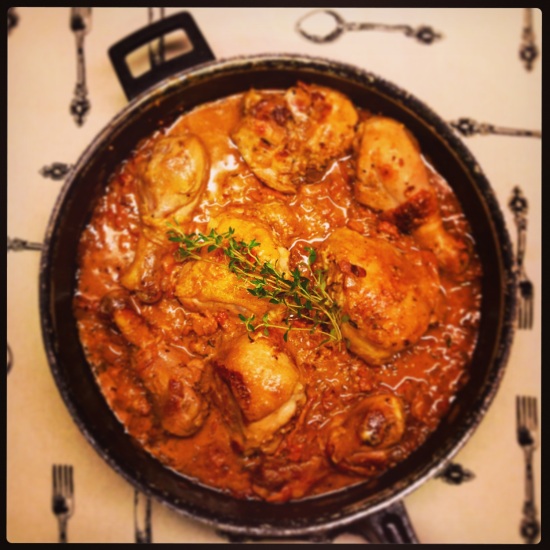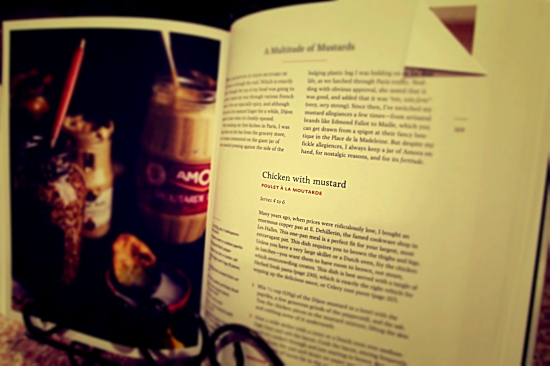
As I mentioned in a previous post, I recently got my hands on a copy of David Lebovitz’s cookbook My Paris Kitchen. I’ve been anxious to try my hand at some of the recipes contained therein (all the recipes, actually), so I set aside some time last night for my first attempt at Poulet à la Moutarde (Chicken with Mustard). It turned out great, and I especially like that it’s one of those meals that looks and tastes quite fancy but is, in actuality, terribly easy to prepare.
Even though I don’t eat meat, I don’t mind cooking it for my husband, and as much as I hate to admit it, it does make the house smell incredible. This dish relies on not one but two species, as it calls for bacon to flavor the chicken and the sauce (three species if you count the cow that supplies the crème fraîche or heavy cream). Though I didn’t taste the resulting feast, my husband assures me that this little triumvirate of beasts was not sacrificed in vain.
Poulet à la Moutarde from My Paris Kitchen by David Lebovitz
Ingredients
- 1/2 cup plus 3 tablespoons of Dijon mustard
- 1/4 teaspoon of sweet or smoked paprika
- Freshly ground black pepper
- 3/4 teaspoon of sea salt or kosher salt
- 4 chicken thighs and 4 chicken legs
- 1 cup diced smoked thick-cut bacon
- 1 small onion, finely diced
- 1 teaspoon of fresh thyme leaves (or 1/2 teaspoon dried)
- 1 cup of white wine
- 1 tablespoon of whole mustard seeds or grainy mustard
- 2 to three tablespoons of crème fraîche or heavy cream
- Warm water (may not be needed)
- Chopped fresh flat-leaf parsley or chives (for garnish)
Directions
- Mix 1/2 cup of the Dijon mustard in a bowl with the paprika, a few generous grinds of the peppermill, and the salt. Toss the chicken pieces in the mustard mixture, lifting the skin and rubbing some of it underneath.
- Heat a wide skillet with a cover or a Dutch oven over medium high heat and add the bacon. Cook the bacon, stirring frequently, until it’s cooked through and just starting to brown. Remove the bacon from the pan and drain on paper towels. Leave about 1 tablespoon of bacon fat in the pan, discarding the rest. Add the onion and cook for about 5 minutes, until soft and translucent. Stir in the thyme, and let cook for another few minutes, and then scrape the cooked onion into a bowl.
- Add a little bit of olive oil to the pan, if necessary, and place the chicken pieces in the pan in a single layer. (If they don’t all fit, cook them in two batches.) Cook over medium-high heat, browning them well on one side, then flip them over and brown them on the other side. It’s important to get the chicken nicely colored as the coloring—as well as the darkened bits on the bottom of the pan, called the fond—will give the finished sauce its delicious flavor.
- Remove the chicken pieces and put them in the bowl with the onions. Add the wine to the hot pan, scraping the darkened bits off the bottom with a sturdy flat utensil. Return the chicken pieces to the pan along with the bacon and onions. Cover and cook over low to medium heat, turning the chicken in the sauce a few times during cooking, until the chicken is cooked through, about 15 minutes. Check doneness by sticking a knife into the meat next to the thigh bone; if it’s red, continue cooking for a few more minutes.
- Remove the pot from the heat and stir in the 3 tablespoons Dijon mustard, the mustard seeds, and the crème fraîche. If the sauce has reduced and is quite thick, you can thin it with a little warm water. Sprinkle chopped parsley over the top and serve.
Despite how tasty this dish turned out, it’s not very pretty to look at while in progress (raw meat, and all), so I’m only going to share a few highlights:






Notes:
- In his cookbook, Lebovitz sings the praises of several fancy brands of real French Dijon. The nicest stuff my local grocery store keeps in stock is the kind from those famous “Pardon me, do you have any ____?” commercials. Seemed to work just fine, though I would imagine the taste would improve with a proper French version.
- For some reason, my bacon didn’t produce a lot of grease—not even the tablespoon that the onions are supposed to cook in—so I added a smidge of olive oil to the pan.
- For the cup of white wine, I used Savignon Blanc, which I always use. Savignon Blanc and Pinot Grigio are good go-to dry white wines for cooking. I think the best rule of thumb is to use wine that you also like to drink, though I would probably steer clear of Chardonnay, as well as anything super sweet like Riesling.
- I used a full three tablespoons of heavy cream (I would’ve made a batch of crème fraîche but my grocery store didn’t have buttermilk) and I didn’t thin the sauce with warm water. It didn’t seem too thick to me, and I think water would’ve diluted the flavor.